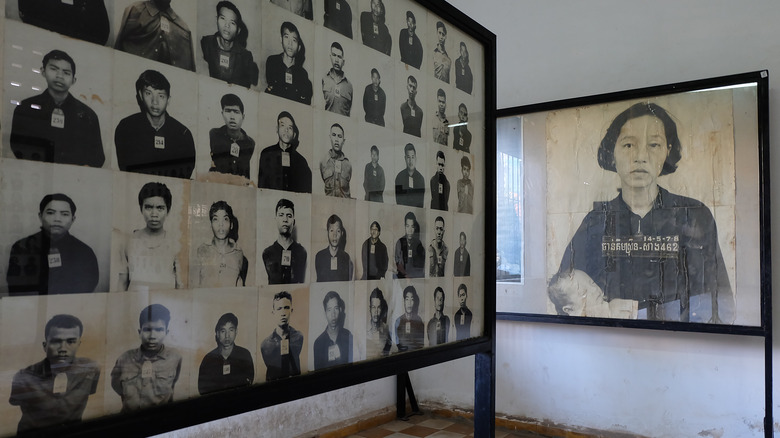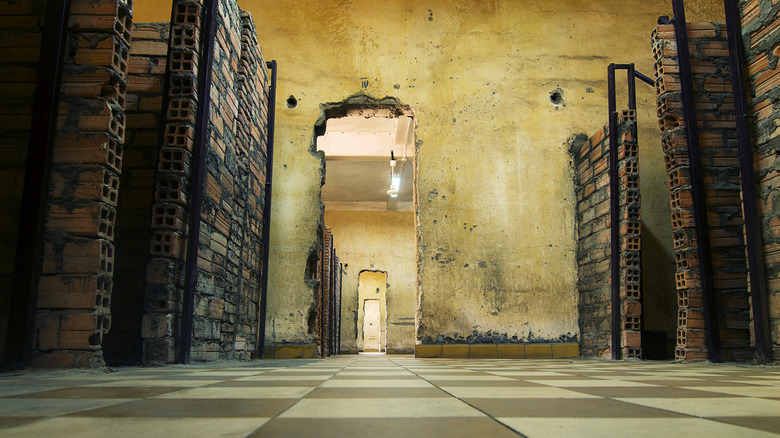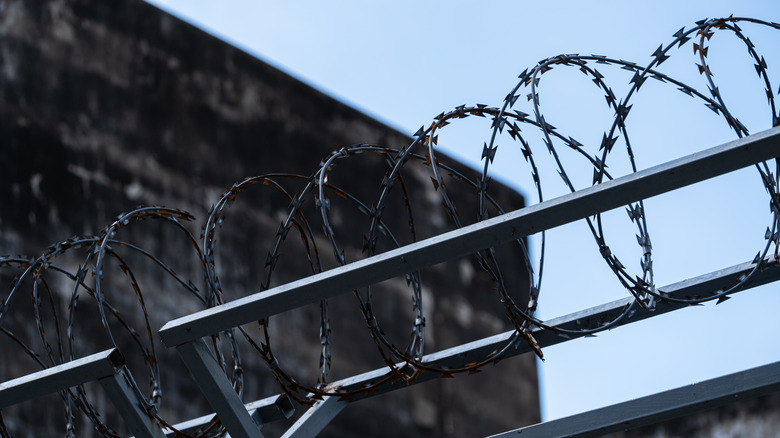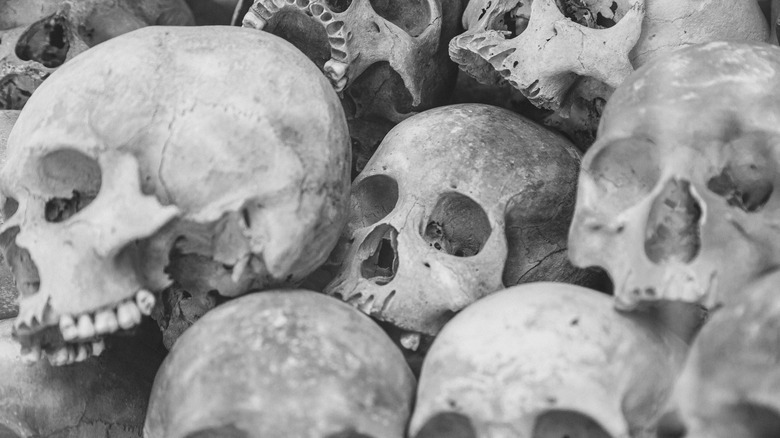Poor Eyesight Could Have Been A Death Sentence Under Cambodia's Khmer Rouge
It's easy to get lost wandering the narrow, gridded lanes of Phnom Penh, capital of Cambodia. The downtown's sprawling, dense network of streets goes on and on past endless rows of greenery, locals on the sidewalk sitting in colorful plastic chairs, and charming eateries serving global cuisines. It's a city undergoing great economic change, one almost unrecognizable in comparison to a scant 45 years ago when it was mired in a deplorable and shocking genocide. And yet, plenty of marks remain from the past, left intentionally intact for future generations to see, like the Tuol Sleng Genocide Museum.
From the outside, Tuol Sleng Genocide Museum looks like a battered, abandoned concrete school encased behind a wall lined with barbed wire. From 1975 to 1979, up to 17,000 prisoners passed through Tuol Sleng and were tortured, beaten, electrocuted, waterboarded, interrogated, and executed, per the United States Holocaust Memorial Museum. Approximately 99% of its prisoners died, as UNESCO says, and it was only one of 196 documented sites throughout Cambodia. In the end, up to 2.8 million people — 25 to 30% of the entire country — died in the Khmer Rouge's "Super Great Leap Forward" (per UCLA and UNESCO, respectively). Led by Pol Pot, Cambodia's Khmer Rouge communist party abolished private property, religious practices, money, civil rights, and forced every Cambodian into countryside communes. Those deemed "impure," per the USC Shoah Foundation, were executed: doctors, lawyers, teachers, people who spoke foreign languages, ethnic minorities, and even just those who wore glasses.
Reset to Year Zero
The Khmer Rouge began as a fringe, militant political movement hiding in the jungles of northeastern Cambodia in the 1960s, as the United States Holocaust Museum says. Known then as the Communist Party of Kampuchea (the ancient name for Cambodia) and led by their reclusive, secretive leader Pol Pot, they waited for the right opportunity to strike. When civil war broke out in Cambodia in 1970, they seized power, and by 1975, they overran the nation's capital, Phnom Penh.
Pol Pot, born Saloth Sar, was an admirer of the Chinese tyrant and butcher Mao Zedong, who killed 45 million Chinese people during his "Great Leap Forward" communist reformation from 1958 to 1962 (per the United States Holocaust Museum and The Washington Post). Red was the color of Mao's China, which is where the term "Khmer Rouge" comes from. Pol Pot had taken a shine to communism while in France, per Cambodia Tribunal Monitor — "rouge" is French for "red."
Pol Pot and the Khmer Rouge wanted to reset the clock on Cambodia society back to "Year Zero," per the BBC. Since he and his troops had been living in the hills and jungles, he figured everyone else should do the same. According to History Place, he wanted to form an "agrarian utopia" free of Buddhism, money or property, or Western influences such as those left behind by French colonialism from 1887 to 1954. Such influences included clothing, language, and accessories like glasses (per the BBC and Cambodia Tribunal Monitor).
The Killing Fields
It took less than four years for the Khmer Rouge to fizzle out, thanks to the military intervention of neighboring Vietnam. The Khmer Rouge had come to power in 1975 the same year that Ho Chi Minh and his north Vietnamese troops overran Saigon, which was only two years after American forces finally withdrew from Vietnam, as History Place says. Rather than try to liberate Cambodia from the Khmer Rouge's fellow extremist communists, the Vietnamese government wanted to ensure its own safety in the region, as historian Bernd Schaefer says in the Khmer Times. The Khmer Rouge scattered back into the jungles in 1979, and Vietnam eventually withdrew a decade later in 1989 (per the BBC and BBC, respectively).
In the three-plus years of Khmer tyranny from 1975 to 1979, they killed up to 2.8 million people, per UCLA. The numbers are vague because of the mania driving the massacre. Direct imprisonment, torture, and execution killed many people, but many more died from the Khmer Rouge's weeks-long marches in areas of land that came to be known as the Killing Fields, per Culture Trip. As the Cambodian Museum says, "Many die along the way. We arrive in the countryside, and are assigned to heavy labor digging an irrigation canal. Others plant rice. Children fertilize the fields. Those that disobey disappear. This is the new world order: Pol Pot's Year Zero. Affection is forbidden. Laughter is rare. Punishment is swift and ruthless. Death is everywhere."
Marks of intellectualism
Even discounting the unbelievable cruelty and stunning illogic needed for the Khmer Rouge to kill millions of its citizens in the name of building a utopia, why the targeting of "intellectuals"? Simply put, as the University of Minnesota says, intellectuals were a threat to the Khmer Rouge's power. People with knowledge from the outside world, either through education or travel, were a danger to the kind of government-dominated, insular nation that the Khmer Rouge wanted to build.
This is why the Khmer Rouge only kept farmers and uneducated peasants alive. It's also why they disassembled families and sought to obliterate the family unit itself and why no one was beholden to anyone but their true "mother and father," the party itself, as Cambodia Tribunal explains. Families couldn't live together, couldn't laugh, show affection, or even gather in groups of three or more out of fear of sowing descent.
The Khmer Rouge was so obsessively paranoid and terrified of losing power — as all dictatorial powers are — that even glasses were a sign of corrosive influence and Western elitism. It's as simple as that. It sounds so unbelievable that folks have questioned whether it's true or not, as evidenced in threads on Quora and Reddit, videos on YouTube, and study guides on Study.com. The short answer is "yes." For a longer answer, we can ask mechanic Chum Mey and artist Bou Meng, whose skills kept them alive in Tuol Sleng prison, where they volunteer to this day (per the BBC).



